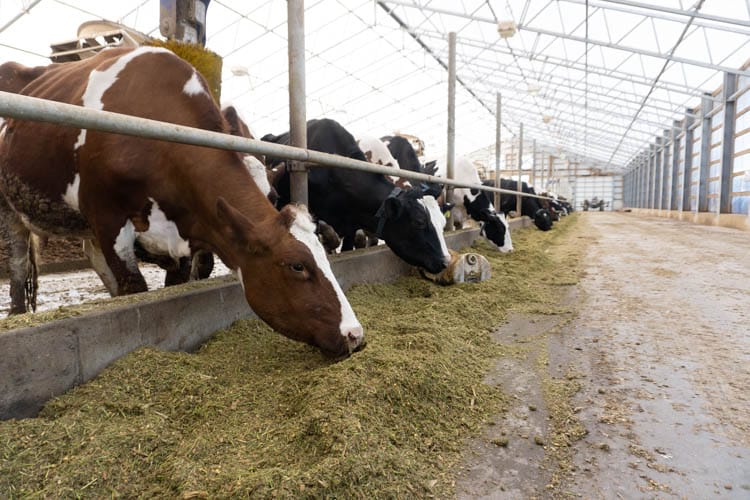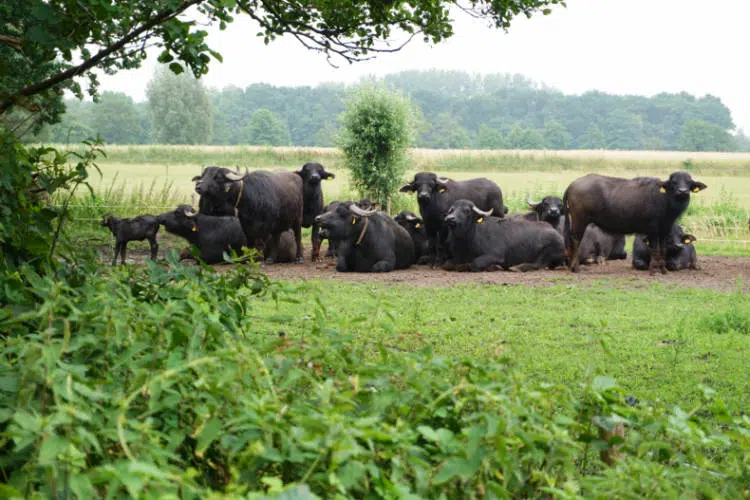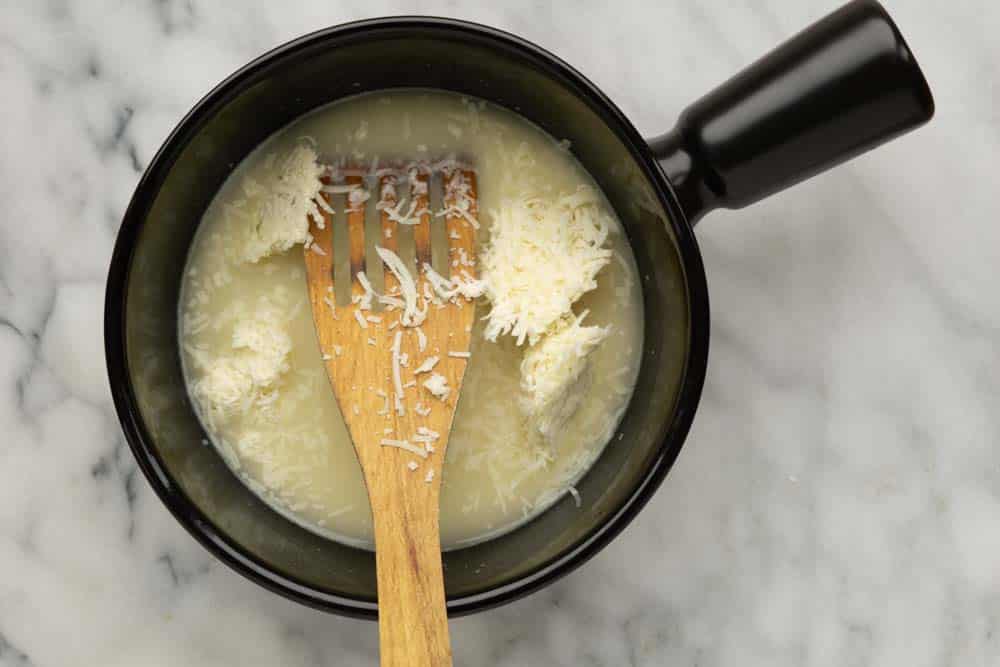Learn the science behind:

The Science of Cheese
From protein science, to milk analysis, from paneer, to Parmigiano, the world of cheese is a big and complex one. It’s easy to build an entire career around the topic of cheese-making, make that more than one career if you include plant-based cheeses.
The science of cheese is fascinating and it’s why we’ve written about it on FoodCrumbles in quite a few places. Here, we’re collecting that knowledge together in one place.
Cheese starts as milk
Cheese starts out as milk. A complex, fascinating product full of proteins, fat, sugars and plenty of minerals and vitamins, that just so happens to be perfectly suited to making cheese. Cheese has been made all over the world in wide variety of cultures, with each their own techniques and specialties. But, the basics of cheese, and the science behind it, is the same for any.
For now, we’ll focus on milk from animals, though the quality of cheese from plant-based sources, such as nuts is improving rapidly as well. This creates a whole new subset of product types and experiences, some of which wouldn’t even have been possible with animal milk! However, since the science behind these plant-based alternatives is quite different from that of animal-based cheese, we’ll discuss those separately.

Where milk comes from
Most cheeses start out as cow’s milk, though milk from goats, sheep, buffalo, camels and various other animals can also all be used to make cheese.
Dairy farming is a quickly developing with a lot of changes and developments happening, especially with regards to sustainability.
Since cheese starts out as milk, we decided to start out on a dairy farm.
Buffalo vs Cow’s milk
Each type of animal milk is slightly different. For instance, milk from buffaloes naturally contains more fat than cow milk. This impacts the quality of the cheese that’s made from it and may enable new and different varieties of cheese.

Making cheese
Once you have your starting material, milk, it’s time to process into cheese. There is not one way to make cheese. Just like there is not one way to make bread. There are hundreds, if not thousands of ways to make cheese. A wide range of cheeses has been developed around the world influenced by local preferences, but also by the local climate and available resources.

Cheese making process
That said, there are some recurring steps that can be found in many cheese making processes. Generally, making cheese starts by making a curd from milk. This can be done using acid, rennet, maybe also using the help of some micro organisms. That curd may then need to be pressed to create a firm structure.
The curd is what will be the cheese. To add extra flavor and texture, some curds are injected with microorganisms such as molds or bacteria. Others are ripened for long periods of time under specific conditions.
Making paneer – at home
Some cheeses take year(s) to make. Others can be done in a matter of minutes! These cheeses do look and behave very differently to one another, but have each gotten their own useful place in cooking.
Paneer is an example of a very fast cheese. It can be made within half an hour and serves as a protein base for many vegetarian dishes from South Asia.


Making mozzarella
Fresh mozzarella is another quite fresh, thus fast, cheese. It can’t be made as quickly as paneer, but can still be done in a matter of days.
Whereas paneer is firm and ‘short’ in texture, mozzarella is soft, squishy, and very stretchy. This is because of a special process that aligns and stretches all those cheese proteins to form the right texture.
Using rennet to curdle cheese
To make paneer, acid is used to curdle the cheese. However, this is by far not the most commonly used method to make cheese. Instead, many milks are curdled by adding rennet.
Rennet is an enzyme, naturally present in a calf’s stomach (but can now also be made without the need for an animal). This enzyme cuts up specific milk proteins, causing the milk to curdle.


Making processed cheese
Most cheeses don’t melt great, or can’t always form the desired texture. It’s one of the reasons processed cheese was invented.
Processed cheese is made from cheese, but also several other additives such as oils, and, most importantly, emulsifiers. These emulsifiers ensure processed cheeses can melt beautifully, without splitting, making them great for topping a hot hamberger for instance.
The Fundamentals of cheese science
Understanding cheese, starts by understanding the components of milk. The final cheese contains most of the fat and about 80% of the protein of the original milk. Just how these ingredients interact determines whether a cheese is firm, creamy, or maybe crumbly.
The crucial role of casein proteins
As we mentioned, a crucial step for making cheese is forming curds. These curds wouldn’t have been possible without casein proteins.
Casein proteins are already present in milk, but there they just form small, clusters, not visible to the human eye. However, under the right conditions, this group of proteins, because it’s not just one type, can form large 3D clusters.
A common way to do so is by adding acid, or rennet. Understanding how casein proteins work and what there role is, is crucial for making cheese.

Using Cheese
Apart from just eating cheese as is, there are a lot of ways in which you can use cheese. Keep in mind here that every cheese is different. Some melt easily, others don’t at all, others have a very strong flavor, whereas the next might be bland in taste. Choosing the right type of cheese for your application is half the journey, the other half is understanding how your cheese works, so you get what you’re looking for.

Making cheese fondue
Originally, a way to use up left over cheese, nowadays a delicious meal by itself. Cheese fondue sounds simple, melt some cheese, mix it with wine and it’s done.
But, cheese fondue can be finicky. It may form clumps, or the fat may split from the rest of liquid. Choosing the right style of cheese is crucial (e.g. slightly ripened, not too dry, with some fat), but also how you put it together. And, the wine is in there for a reason, not just for the alcohol, it adds just the right level of acidity to prevent stringy fondue!
Topping a quiche (or pizza) with cheese
The cheese you need for a fondue can be quite the opposite to one you’re looking for when topping a pizza or quiche. You might actually be looking for a stretchy cheese, and preferably also one that melts when and maybe turns a nice brown color. You definitely don’t want a cheese that simply burns.

Storing cheese
Some cheeses are made to be stored for months, years even. Others can be stored for a few days at the most. The ideal storage conditions depend a lot on the type of cheese. For instance, a form, hard cheese might be well suited to a vacuum pack. However, a soft, squishy cheese will not hold up well under those conditions, it will be compressed undesirably!

Grated cheese requires extra protection
Grated cheese is more susceptible to spoilage than a block of cheese. This is because of its large surface area. It makes it a great place for molds to hang out and grow.
You may have also noticed that once you open a pack of grated cheese, it’s shelf life goes down considerably (that is, if you bought it at a supermarket, not your local cheese shop). This is because factory produced grated cheese is often packaged in a pack with less oxygen and extra carbon dioxide. This slows down mold growth. However, once the pack is open, that protection is gone!
What's your challenge?
Struggling with your food product or production process? Not sure where to start and what to do? Or are you struggling to find and maintain the right expertise and knowledge in your food business?
That's where I might be able to help. Fill out a quick form to request a 30 minute discovery call so we can discuss your challenges. By the end, you'll know if, and how I might be able to help.




